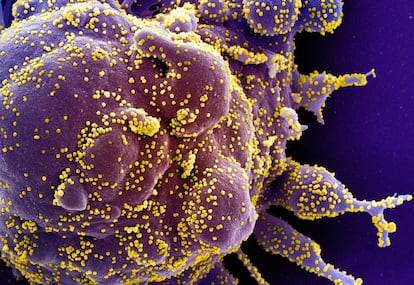How Spain’s sixth wave compares: more cases than ever but nearly half the number of hospital admissions
The risk of hospitalization due to Covid-19 is currently lower, but infections are beating all records and that will still put pressure on the healthcare system. ICU admissions are at 44% of the worst peak in January 2021

Spain is currently immersed in a different wave of the coronavirus pandemic. On the one hand, infections are still spiking and are a reason for concern. On the other, there is ever-increasing evidence that the new omicron strain is causing lower levels of serious illness, in particular among the vaccinated.
These two forces will determine the severity of the current wave. While each infection currently leads to fewer hospitalizations, the multiplication of these infections could see admissions spike, leaving thousands of people sick, and once again putting great stress on Spain’s healthcare system. Avoiding this depends on at least one piece of good news being proven: either omicron is much milder than the previously dominant strain, delta, or that it causes shorter waves and cases will soon start to fall again.
For now, the available data show record high rates of infection in Spain. In the last seven days, more cases than ever have been registered during the pandemic – 60% up on the worst situation in January 2021. The speed with which these cases are rising is showing no sign of letting up, and that velocity is the main reason to remain on alert. While infections continue to rise, omicron will remain a potential threat.
Hospitalizations are also on the rise in Spain. But by how much? This graph compares the current curve and that of January 2021, which saw tens of thousands of hospital admissions and 18,000 deaths. The current figures are far from the worst of those weeks, but they are growing and are by no means insignificant: daily admissions are already at 39% of the peak back then. And admissions into intensive care units (ICUs) are worse, and are nearly at half of that peak (44%), and continue to rise.
The Spanish Health Ministry also offers data on ICU admissions that require respirators, and those figures are also rising in many of the country’s regions. In Catalonia, for example, daily admissions occupy 2.2% of available beds (without including discharges), compared to 3.4% during the worst moment of January 2021. In the Basque Country the figure is 2% compared to 3% in January. And in Asturias, it’s 1.3% compared to 3% at the start of the year.
This data should be approached with two caveats. The first is that, for sure, some of these admissions are for other reasons, but the patients in questions have Covid-19. There are no exact figures, but according to data from the United Kingdom 75% of admissions are Covid-19 patients while 25% are patients who are suffering from another ailment but have Covid-19.
Nor do we know how many patients have delta or omicron. In Spain, the arrival of the new variant coincided with a waning wave of delta. That is why it is difficult to know whether the admissions we are seeing are caused by one strain or the other. It is still possible that omicron cases translate into a lower proportion of hospitalizations, as suggested by preliminary studies in other countries. But it is possible we are not seeing this if there are still admissions due to delta. This unknown will have to be resolved in the coming weeks.
Is the infection curve flattening?
Until we have definitive information on the exact severity of omicron among the vaccinated, the clearest way out of this wave is simple: for infections to fall. In South Africa, where omicron was first identified, the wave peaked in four weeks, which is twice as fast as with delta. There are experts who believe that this could be a characteristic of the new strain.
In Spain, for now, there are no signs to suggest this is the case. If we plot a logarithmic scale with the progress of cases by region, we can see straight lines – that’s to say, exponential growth with no drop off.
However, after two years of pandemic we know that epidemic curves fall fast. The best news this week would be to see that, with new positive cases being lower than those registered last week. Even so, the celebrations will have to be put on hold, given that there are often delays in reporting data when there are national holidays in the week. But it would still be the best news possible right now.
Tu suscripción se está usando en otro dispositivo
¿Quieres añadir otro usuario a tu suscripción?
Si continúas leyendo en este dispositivo, no se podrá leer en el otro.
FlechaTu suscripción se está usando en otro dispositivo y solo puedes acceder a EL PAÍS desde un dispositivo a la vez.
Si quieres compartir tu cuenta, cambia tu suscripción a la modalidad Premium, así podrás añadir otro usuario. Cada uno accederá con su propia cuenta de email, lo que os permitirá personalizar vuestra experiencia en EL PAÍS.
¿Tienes una suscripción de empresa? Accede aquí para contratar más cuentas.
En el caso de no saber quién está usando tu cuenta, te recomendamos cambiar tu contraseña aquí.
Si decides continuar compartiendo tu cuenta, este mensaje se mostrará en tu dispositivo y en el de la otra persona que está usando tu cuenta de forma indefinida, afectando a tu experiencia de lectura. Puedes consultar aquí los términos y condiciones de la suscripción digital.
Últimas noticias
Most viewed
- Sinaloa Cartel war is taking its toll on Los Chapitos
- Oona Chaplin: ‘I told James Cameron that I was living in a treehouse and starting a permaculture project with a friend’
- Reinhard Genzel, Nobel laureate in physics: ‘One-minute videos will never give you the truth’
- Why the price of coffee has skyrocketed: from Brazilian plantations to specialty coffee houses
- Silver prices are going crazy: This is what’s fueling the rally









































